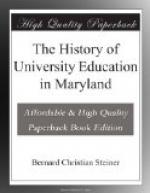Indeed, from 1805 to 1816, nothing but a grammar school seems to have been maintained in the college building. In the latter year, however, the college was re-opened, since the legislature had granted it a lottery of $30,000. A year later Rev. Dr. Francis Waters became “Principal,” and under his able leadership the college bid fair to regain its old position; but in 1827 a second great misfortune overtook it. On January 11, 1827, the college building was discovered to be on fire, and, in spite of the most zealous efforts, was entirely consumed. After this misfortune the college proper seems to have been suspended a second time, and only a grammar school maintained with one instructor. The classes were conducted in a building intended originally for a rectory, until that was destroyed by fire in 1839, when the school was again moved.
Richard W. Ringgold, the principal of the school from 1832 to 1854, seems to have been a man of ability, and under him the number of students so much increased that in 1843 it was resolved to rebuild the college on the old site and to revive the college course. As a result, the present main building was erected, the corner-stone laid with imposing ceremonies on May 4, 1844, and the college was reopened in its own edifice on January 1, 1845. In 1849, a class of four was graduated, and in 1854, two additional buildings were erected; one for the Principal’s residence and the other for dormitories and recitation rooms.
The college continued prosperous during the second administration of Rev. Dr. Waters from 1854 to 1860; but in the presidency of his successor, Rev. Andrew J. Sutton, came the Civil War, depriving the college of its Southern constituency and distracting men’s minds from learning. After the Rebellion, an unfortunate selection of teachers and laxness of discipline caused the college to lose still more ground, and Wm. J. Rivers, Principal from 1873 to 1887, had much to do to build it up again. He was a faithful and diligent teacher, and under him the moral tone of the college was improved and the course of instruction enlarged. The present head, C.W. Reid, Ph.D., is still further advancing the cause of the institution and a new career of prosperity seems opening before Maryland’s oldest college and the only one on the Eastern Shore of the Chesapeake Bay.
St. John’s College, like its sister institution, founded on a non-denominational basis, started out under even fairer auspices.[9] It was granted, by the State, Governor Bladen’s mansion and four acres of land surrounding it, was made heir to the funds of King William’s School, and secured L9,000 from private beneficence in the first two years of its history. The Bladen mansion, now known as McDowell Hall, was repaired and enlarged and, on August 11, 1789, Bishop Carroll was elected president of the Board of Visitors and Governors and Dr. John McDowell accepted the Professorship of Mathematics. After unsuccessful attempts to obtain a principal




